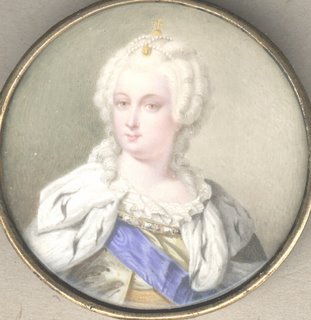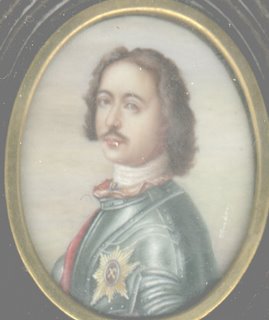But when one thinks of the circumstances, it is a rare survivor. A year, later in 1914, Germany was at war with Russia, so a German artist living in Berlin could not risk painting a portrait of the Russian royal family. Four years later the Tsar had been deposed and in 1918 the whole Romanov family was murdered, so it also became dangerous for Russians to own a portrait of their royal family. Thus there can be very few contemporary miniature portraits of the family still in existence.
Blattel records very little about Adolf Helzel, only that he he lived in Bodenbach and Bohemia, was active in 1894, and was an owner of a porcelain painting company with his brothers, Emanuel and Heinrich. Other family members may have included August Helzel, and an earlier glass blower, Wilhelm Helzel. Adolph Helzel exported champagne and other wines glasses to the United States, but the New York Times reported that the importing agents ran foul of Customs with their declared values, which were held to be too low.
 A little research suggests that he was likely the son of Franziskus Helzel and Aloisa Ludovia Guirand who were married there on 31 December 1846. He married Adelaide Amalie Suchy on 23 August 1875 at Stein-Schooenau, Decin, Czechoslovakia and they had a daughter, Martha Melanie Wilhelmine Helzel who was born on 27 September 1882. Martha married Robert Carl Joseph Emil Manzer on 19 October 1910 at Karlsbad, Vary Karlovy, Czechoslovakia and died on 30 December, 1949.
A little research suggests that he was likely the son of Franziskus Helzel and Aloisa Ludovia Guirand who were married there on 31 December 1846. He married Adelaide Amalie Suchy on 23 August 1875 at Stein-Schooenau, Decin, Czechoslovakia and they had a daughter, Martha Melanie Wilhelmine Helzel who was born on 27 September 1882. Martha married Robert Carl Joseph Emil Manzer on 19 October 1910 at Karlsbad, Vary Karlovy, Czechoslovakia and died on 30 December, 1949.The collection also includes another miniature signed; "A Helzel Berlin". The sitter is H.R.H. Ernst August, Duke of Cumberland (1845 - 1923), formerly the Crown Prince of the Kingdom of Hanover. He was a great grandson of King George III of England. He wears the uniform of the Austrian Infantry regiment of which he was honorary Colonel. As such he was a distance cousin of Olga and Tatiana. Blattel says Helzel was active around 1894, but these two portraits suggest he was still active twenty years later.




The original studio or news photo of 1913 that the miniature was copied from is shown here. There are several in the series in different poses, but it is clear this was the inspiration for the miniature. During her lifetime, Olga's future marriage was the subject of great speculation within Russia. Matches were rumored with Grand Duke Dmitri Pavlovich of Russia, Crown Prince Carol of Romania, Edward, Prince of Wales, eldest son of Britain's George V, and with Crown Prince Alexander of Serbia. Olga herself wanted to marry a Russian and remain in her home country. Olga's murder following the Russian Revolution of 1917 resulted in her canonization as a passion bearer by the Russian Orthodox Church. In later years, when dozens of people made claims to be surviving members of the imperial family, a woman named Marga Boodts claimed to be Grand Duchess Olga, but her claim was not taken seriously.
Tatians was better known than her three sisters during her lifetime and headed Red Cross committees during World War I. Like her older sister, Olga, she nursed wounded soldiers in a military hospital from 1914 to 1917, until the family was arrested following the first Russian Revolution of 1917. Their murder by revolutionaries on 17 July 1918 resulted in her being named as a passion bearer by the Russian Orthodox Church. They was assassinated along with her family at Ekaterinburg. Their remains were identified through DNA testing and were buried during a funeral ceremony in 1998 at Peter and Paul Cathedral in St. Petersburg along with those of her parents.
A legitimate question for collectors is; "Is this a decorative miniature?" There is no straight answer to that, with the miniature showing there was a cross-over between "genuine" and "decorative" miniatures. This was not new in 1913, one hundred years earlier Henry Bone and his son Henry Pierce Bone copied other portraits, and their enamel miniatures are now highly prized.
Early and Modern Russian Decorative Miniatures

 Elsewhere in this collection are a number of decorative miniature portraits of Russian monarchs. They include Peter the Great and Catherine the Great. 844a, 868
Elsewhere in this collection are a number of decorative miniature portraits of Russian monarchs. They include Peter the Great and Catherine the Great. 844a, 868 
 Also a miniature portrait by an unknown artist, which is a copy of a well known portrait of Alexander I (1777-1825) and one of Nicholas I (1796-1855). 1120 1058
Also a miniature portrait by an unknown artist, which is a copy of a well known portrait of Alexander I (1777-1825) and one of Nicholas I (1796-1855). 1120 1058
 Since 1990 the Russian royal family has regained nostalgic popularity, to the extent that decorative miniatures are again being painted, some of them are of a high standard. Shown here are four Russian miniatures painted since 2000. They are of Tsar Nicholas II and his wife Alexandra, together with two of his children, Grand Duchess Tatania amd Grand Duchess Anastasia.
Since 1990 the Russian royal family has regained nostalgic popularity, to the extent that decorative miniatures are again being painted, some of them are of a high standard. Shown here are four Russian miniatures painted since 2000. They are of Tsar Nicholas II and his wife Alexandra, together with two of his children, Grand Duchess Tatania amd Grand Duchess Anastasia.This type of miniature is called Fedoskino or Palekh miniatures, after the Russian villages where many are still painted using lacquer on a papier-mache base. For more about them see Russian lacquer miniature - Fedoskino These can be purchased relatively inexpensively and would make a great basis for a collection for anyone interested in collecting miniature art, but with a tight limit on the amount of money they can spend.

 Thus miniatures by Fedoskino artists provide a means of forming an attractive and inexpensive collection, and in doing so provide an insight into the times and events associated with the original sitters.
Thus miniatures by Fedoskino artists provide a means of forming an attractive and inexpensive collection, and in doing so provide an insight into the times and events associated with the original sitters.


1 comment:
As a collector of revival miniatures I found this particular miniature, of the Grand Duchesses Olga and Tatiana, to be the most fascinating of your recent collection additions.
Post a Comment